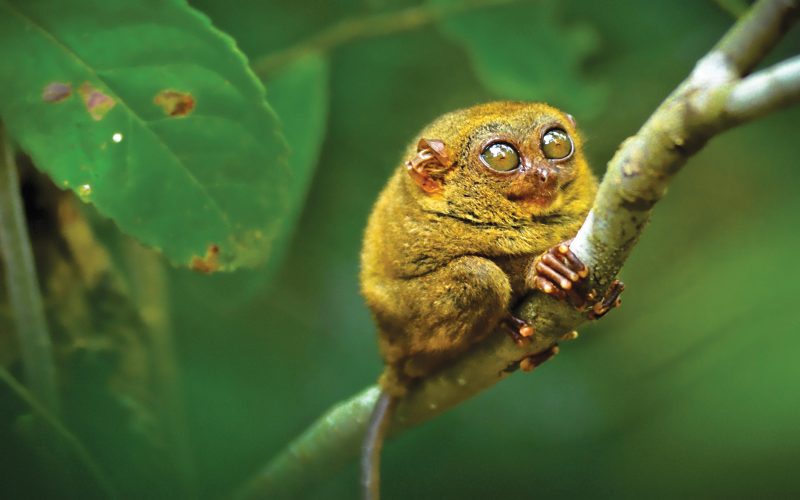It is pitch dark and the night is full of sound: cicadas, the waves of the Molucca Sea, and the music of the rainforest frogs. Led by torchlight, we search for one of the world’s smallest primates: the tarsier.
My wife Lina and I have come to the dense jungles of the Tangkoko-Batuangus Nature Reserve to track down the spectral tarsier (Tarsius tarsier): one of the smallest primates in the world. Tarsiers are the only wholly carnivorous primate, preying on insects, birds, and frogs, among others. Stealthy hunters, they can uncannily jump on or grab their oblivious prey. But being nocturnal and arboreal, tarsiers are difficult to spot in their natural habitat. Will we get more than just a glimpse?
We drive east from Manado to the 8,718-hectare Tangkoko nature reserve in the northeast peninsular of Sulawesi, Indonesia. The road twists round hairpin bends and passes rustic farmland and traditional houses with holy crosses standing like sentinels in front. There seems to be a test to enter the reserve: a rickety bamboo bridge above an overflowing canal. We drive carefully across. The car wades through mud and slush, then a half-paved road leads into tall woods and we hear the sound of the sea.
We meet our guide Fernando at a concrete shelter for rangers. He wears a headlamp and scratches at his legs. “How itchy is it going to be?” Lina anxiously asks. “Ngak apa,” Fernando smiles. “A little bit only. You must have bought repellents.” Lina busily sprays her hands and legs while I register our names in the visitor’s book and pay the Rp150,000 entrance fees (about US$16).
We trudge into the jungle, leaving behind the barking dog and the ranger shelter. The wild grass cunningly hides the narrow path, making for awkward passage. Fernando cuts through plants whose tops have wound together and blazes a new trail through the vegetation with his machete. The grasses give way to giant trees. “Hati-hati, leeches to your left,” Fernando warns, pointing to a swampy patch. Above, the jungle canopy obscures the sky so the first raindrops take us by surprise. I can hear the sea.
We arrive at the sandy slopes of the shore. The pristine water wears an azure robe. It’s not dark yet and the virgin beach beside the virgin forest is stunning. The fallen leaves and sand conjure up some wild, natural smells in the falling drizzle. Sea-swept shells of different shapes and designs lie strewn across the sand. There are no urchins here to collect and sell as we sometimes see on city beaches. I think of the beaches of southern India and the sons of fishermen vying with each other for possession of the shapeliest shells.
At 6pm the ochre woods begin to darken. With reluctant hearts we leave the shore. Fernando peers into the tree tops and we follow his gaze. Up among the branches of the jungle canopy is a world like another planet – with routines we know very little about.
One by one, but with distinctly different pitches and intensities, the tarsiers begin their collective dusk chorus. We track their ululations. Fernando knows the trees the tarsiers favour: tall, thick fig trees with cosy crevices and hollows in which to dwell. Suddenly we see a dozen black crested macaques. They appear friendly, coming close to us and giving us the opportunity to get close-range photographs. Meanwhile, the tarsiers keep calling, their howls and the echoes of their howls misleading us here and there.
Fernando reminds us to be patient and silent. We search for trees with hollows. When he hears one call, he creeps in that direction; then swerves at the song of another. We follow him like obedient servants. Suddenly Fernando accelerates through the jungle, and this time doesn’t change course. Have we made a breakthrough?
We see the tail first: that long, slender tail, hanging down like a banyan tree’s roots. “Finally!” I utter. “It’s so small!” Fernando shushes me but notes that tarsiers can grow to 15 centimetres. The tarsier ogles us with its disproportionately large, round eyes. It firmly clasps the tree branch with elongated fingers, reminding me of a baby in arms. Stepping to the right, I am within one metre of the tarsier. Its ears are like dish antennas. The tiny black pupils of its brown eyes seem to convey a message: puzzled, pestered, petrified.
Then from inside the hollow, a second tarsier pokes its head out. It is cautious, but after a few minutes it tentatively leaves the hollow. We inch closer, like an army about to ambush. Fernando’s flashlight illuminates the two tarsiers in a halo of white light. They do not move. I ignore my tripod in my impatience to shoot. To protect their eyes, I disable the flash on my Canon. Fernando’s torch gives sufficient light for me to focus. “So tiny! Tinier than in the pictures,” Lina whispers while videoing them.
The two tarsiers eye each other. One jumps to another branch, perhaps ready to hunt. It is now pitch dark and the night is full of sound: waves on the shore, the persistent clamouring of the cicadas, and the music of the rainforest frogs.
At another tree we see two more tarsiers, one smaller than the other. They are playful: hopping from branch to branch. Fernando speculates these are mating attempts, but there is no such feast for our eyes tonight.
After two hours we trek out of the Tangkoko Nature Reserve, considering ourselves lucky to have been so close to the tarsiers. Their duets, sung at dusk, still echo in my ears.
HOW TO GET THERE
Direct flights are available from Jakarta to Manado. It’s a three-hour ride from this provincial capital to the nature reserve. Transport can be arranged from your hotel.
ACCOMMODATION
We stayed at Hotel Minahasa, an old and reputable hotel near Manado town. It’s a budget hotel though has a presidential suite. Enjoy some delicious Tinutuan (Manadonese porridge) for breakfast.
FOOD GUIDE
Manado will surprise you with some exotic dishes like bat and dog meat among others. You may either want to be a bit adventurous here or just opt to consume other common Indonesian dishes including seafood. One thing I found interesting was the Manadonese have a habit of eating pisang goreng (fried banana) with sambal (chilli paste).





